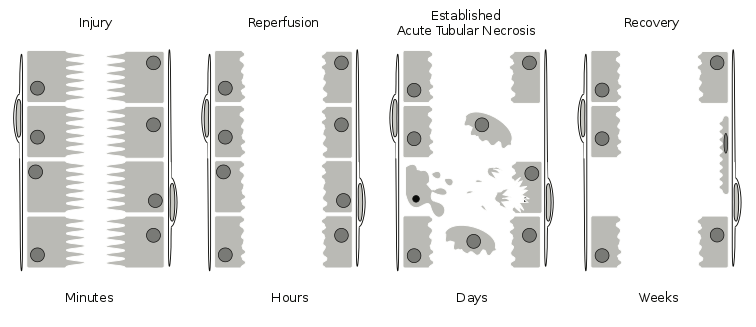What is the Difference Between AKD and CKD
The key difference between AKD and CKD is that AKD is a kidney disease that occurs between 7 to 90 days during the progression of acute kidney injury to chronic kidney disease, while CKD is a kidney disease that occurs due to the presence of kidney damage or decreased GFR for greater than 3 months.
Kidney disease is a condition where kidneys are damaged and can’t filter blood the way that they normally should. There are three main types of kidney diseases: AKI (acute kidney injury), AKD (acute kidney disease), and CKD (chronic kidney disease).
CONTENTS
1. Overview and Key Difference
2. What is AKD
3. What is CKD
4. Similarities – AKD and CKD
5. AKD vs CKD in Tabular Form
6. Summary – AKD vs CKD
What is AKD (Acute Kidney Disease)?
Acute kidney disease (AKD) is a kidney disease that occurs between 7 to 90 days during the progression of acute kidney injury to chronic kidney disease. Acute kidney injury (AKI) is the sudden decline in glomerular filtration rate (GFR). Normally AKI occurs within 7 days. This results in the elevation of serum creatinine (SCr), blood urea nitrogen (BUN), and electrolyte levels. Generally, acute kidney injury is a clinical spectrum that can be rapidly reversible with prompt treatment of underlying causes such as fluid for dehydration and removal of a nephrotoxin. In case of life-threatening fluid overload or electrolyte disturbances, it requires urgent dialysis.

Figure 01: AKD
Moreover, many cases of AKI occur in patients that are hospitalized for unrelated acute illnesses. When the kidney damage is present for more than 3 months, it results in chronic kidney disease. Therefore, kidney disease present during the progression of acute kidney injury to chronic kidney disease is normally defined as acute kidney disease. Furthermore, AKD describes acute or subacute damage or loss of kidney function for a time period of between 7 to 90 days after exposure to an acute kidney injury.
What is CKD (Chronic Kidney Disease)?
Chronic kidney disease (CKD) is a kidney disease that occurs due to the presence of kidney damage or decreased GFR for greater than 3 months. In CKD, kidney damage is characterized by albuminuria, urine cast, imaging findings, and abnormal renal biopsy. The cause of CKD is long-term diseases such as diabetes and hypertension. People with CKD can have symptoms that are a direct result of the reduction of kidney function. These symptoms may include malaise, nausea, decreased mental acuity, edema, and decreased urine output. However, many people do not have symptoms.
There are five stages of CKD based on the extent of kidney damage and glomerular filtration rate (GFR). Furthermore, treatment options for CKD may include high blood pressure medications (ACE inhibitors or angiotensin II receptor blockers), medication to relieve swelling (diuretics), medication to treat anemia (supplement of hormone erythropoietin), medication to lower cholesterol (statins), medication to protect bones (calcium and vitamin D supplements), low protein to diet to lower waste products in the blood, dialysis, and kidney transplant.
What are the Similarities Between AKD and CKD?
- AKD and CKD are two types of kidney diseases.
- In both kidney diseases, serum creatinine can be high.
- In both kidney diseases, blood urine nitrogen (BUN) can be high.
- Both kidney diseases can be due to underlying conditions.
- These conditions can be treated with dialysis.
What is the Difference Between AKD and CKD?
AKD is a kidney disease that occurs between 7 to 90 days during the progression of acute kidney injury to chronic kidney disease, while CKD is a kidney disease that occurs due to the presence of kidney damage or decreased GFR for greater than 3 months. Thus, this is the key difference between AKD and CKD. Furthermore, in AKD, the kidney damage exists for less than three months while, in CKD, the kidney damage exists for more than three months.
The below infographic presents the differences between AKD and CKD in tabular form for side by side comparison.
Summary – AKD vs CKD
AKD and CKD are two types of kidney diseases. AKD occurs between 7 to 90 days during the progression of acute kidney injury to chronic kidney disease, while CKD occurs due to the presence of kidney damage or decreased GFR for greater than 3 months. So, this summarizes the difference between AKD and CKD.
Reference:
1. Levey, Andrew S. “Defining AKD: The Spectrum of Aki, AKD, and CKD.” Nephron, Karger Publishers, 24 June 2021.
2. “Chronic Kidney Disease.” Mayo Clinic, Mayo Foundation for Medical Education and Research, 3 Sept. 2021.
Image Courtesy:
1. “Acute Renal Failure” By ColnKurtz – Own work (CC BY-SA 4.0) via Commons Wikimedia
2. “CKD – Chronic kidney disease” By Scientific Animations (CC BY-SA 4.0) via Commons Wikimedia
ncG1vNJzZmivp6x7pbXFn5yrnZ6YsqOx07CcnqZemLyue9ahmK1lmah6tbTEZpuinpaav6a6wp5km52krLKmuoyaop1lkaOxbq%2FKnWY%3D